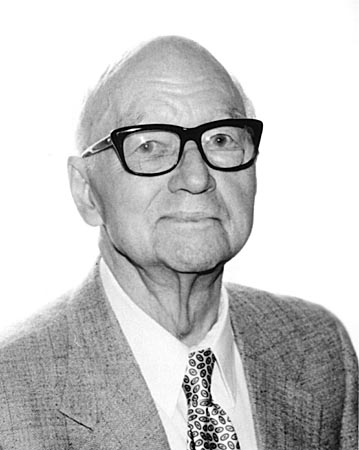Johannes A. Van den Akker was born in California in 1904. He received a bachelor of science degree in 1926 and a doctorate in 1931 from the California Institute of Technology in Pasadena. Between 1931 and 1935, he was an instructor of physics at Washington University for both undergraduate and graduate courses. He was also involved in research using newly-designed equipment.
The intention of Dr. Van den Akker’s doctoral and post-doctoral research was to prove or disprove the correctness of quantum theory in the domain of heavy metals and energetic photoelectrons. The important aspect of the study was the shape of the spatial distribution curves. The publications of his work satisfied his peers that the quantum theory is correct in applications involving x-ray photoelectrons.
The whole program of effort, both at Caltech and Washington University, proved to be of major importance, calling into play a new design of magnetic spectrograph (adapted to the newly-developed Geiger-Mueller tube, a measuring device that locates energy sources). As a result of his success in establishing the correctness of quantum mechanics, Dr. Van den Akker was included in World Who’s Who in Science — From Antiquity to the Present.
In 1935, Dr. Van den Akker was invited to chair the department of physics at the relatively-new Institute of Paper Chemistry in Appleton, Wisconsin. The stock market crash almost completely wiped out new job opportunities, and he considered it “prudent to accept a new and seemingly good opportunity when it came to one’s doorstep.” He chaired the department until his retirement in 1970. He was also chairman of the mathematics department.
Dr. Van den Akker’s fields of specialization included spatial distribution of x-ray photoelectrons; optical properties of paper; spectrophotometry and color measurement instrumentation of all properties of paper; and paper and fiber physics. He led seminal research and developed theories predicting behavior in vitally important industrial areas, such as super calendering; mechanical properties of individual pulp fibers; mechanical properties of paper webs; and optical properties of paper.
The theory development was largely Dr. Van den Akker’s personal efforts. The expansion of this theory and development of applications were done through collaborative research with a number of his students, through interaction with peers around the world, and through industrial contacts. His work has benefited most aspects of the paper industry, but particularly those in the high-grade printing and writing papers, because of his outstanding work in optical and strength properties.
Supercalendering technology was improved as a result of his work. The use and interpretation of data from fiber strength measurements, such as zero-span, have increased in value because of his work.
The understanding of and application of his theories have increased machine speeds and resulting economies available to the industry. More important, the applications of paper properties to a multitude of new product opportunities have resulted from the understanding generated by his theories.
In 1961 and ’62, Dr. Van den Akker was a Fulbright lecturer at the University of Manchester Institute of Science and Technology. Following his retirement in 1970, he became a research and development consultant for American Can Company from 1971 to 1982 and for James River Corporation from 1982 to 1985.
Dr. Van den Akker was a Fellow, American Association for Advancement of Science; Fellow, American Physical Society; Fellow, Optical Society of America; Fellow, Technical Association of the Pulp and Paper Industry; and a member of American Association of Physics Teachers.
He won the TAPPI Research and Development Award in 1967 and the TAPPI Gold Medal in 1968.
Dr. Van den Akker resided in Appleton with his wife, Margaret, until his death in 1999. He often related that his retirement years were the happiest period of his life. Also, he often could not resist commenting that his former classmate, Carl Anderson, who worked in a similar field, discovered the positive electron around 1931 and was a Nobel Laureate in 1936.
